Acute Effect of Cognitive Compromise during Physical Exercise on Self-Regulation in Early Childhood Education
Abstract
1. Introduction
2. Materials and Methods
2.1. Design
2.2. Participants
2.3. Procedure
2.3.1. Without Bike Locomotion Condition (WBL)
2.3.2. Bike Locomotion Condition (BL)
2.3.3. Dramatic Story Condition (DS)
2.3.4. Control Condition (C)
2.4. Measures
2.4.1. Self-Regulation
2.4.2. General Dynamic Coordination
2.4.3. Cognitive Control Estimation
2.4.4. Statistical Analysis
3. Results
3.1. Self-Regulation
3.2. Cognitive Control Estimation
4. Discussion
5. Conclusions
Author Contributions
Funding
Conflicts of Interest
References
- Pontifex, M.B.; McGowan, A.L.; Chandler, M.C.; Gwizdala, K.L.; Parks, A.C.; Fenn, K.; Kamijo, K. A primer on investigating the after effects of acute bouts of physical activity on cognition. Psychol. Sport Exerc. 2019, 40, 1–22. [Google Scholar] [CrossRef]
- Pesce, C.; Crova, C.; Cereatti, L.; Casella, R.; Bellucci, M. Physical activity and mental performance in preadolescents: Effects of acute exercise on free-recall memory. Ment. Health Phys. Act. 2009, 2, 16–22. [Google Scholar] [CrossRef]
- Best, J.R. Exergaming immediately enhances children’s executive function. Dev. Psychol. 2012, 48, 1501–1510. [Google Scholar] [CrossRef]
- Mackie, M.A.; Van Dam, N.T.; Fan, J. Cognitive control and attentional functions. Brain Cogn. 2013, 82, 301–312. [Google Scholar] [CrossRef] [PubMed]
- Diamond, A. The Early Development of Executive Functions. In Lifespan Cognition: Mechanisms of Change; Oxford University Press: Oxford, UK, 2012. [Google Scholar]
- Moriguchi, Y.; Hiraki, K. Prefrontal cortex and executive function in young children: A review of NIRS studies. Front. Hum. Neurosci. 2013, 7, 867. [Google Scholar] [CrossRef]
- McClelland, M.M.; Cameron, C.E. Self-Regulation Early Childhood: Improving Conceptual Clarity and Developing Ecologically Valid Measures. Child Dev. Perspect. 2012, 6, 136–142. [Google Scholar] [CrossRef]
- Tomporowski, P.D.; McCullick, B.; Pendleton, D.M.; Pesce, C. Exercise and children’s cognition: The role of exercise characteristics and a place for metacognition. J. Sport Health Sci. 2015, 4, 47–55. [Google Scholar] [CrossRef]
- Robinson, L.E.; Palmer, K.K.; Bub, K.L. Effect of the Children’s Health Activity Motor Program on Motor Skills and Self-Regulation in Head Start Preschoolers: An Efficacy Trial. Front. Public Health 2016, 4, 173. [Google Scholar] [CrossRef]
- Kim, H.; Duran, C.A.K.; Cameron, C.E.; Grissmer, D. Developmental Relations Among Motor and Cognitive Processes and Mathematics Skills. Child Dev. 2018, 89, 476–494. [Google Scholar] [CrossRef]
- Blair, C.; Raver, C.C. School Readiness and Self-Regulation: A Developmental Psychobiological Approach. Annu. Rev. Psychol. 2015, 66, 711–731. [Google Scholar] [CrossRef]
- Lee, K.; Bull, R.; Ho, R.M.H. Developmental changes in executive functioning. Child Dev. 2013, 84, 1933–1953. [Google Scholar] [CrossRef] [PubMed]
- Tsujimoto, S.; Kuwajima, M.; Sawaguchi, T. Developmental fractionation of working memory and response inhibition during childhood. Exp. Psychol. 2007, 54, 30–37. [Google Scholar] [CrossRef] [PubMed][Green Version]
- Wiebe, S.A.; Sheffield, T.; Nelson, J.M.; Clark, C.A.C.; Chevalier, N.; Espy, K.A. The structure of executive function in 3-year-olds. J. Exp. Child Psychol. 2011, 108, 436–452. [Google Scholar] [CrossRef] [PubMed]
- Zelazo, P.D.; Müller, U. The balance beam in the balance: Reflections on rules, relational complexity, and developmental processes. J. Exp. Child Psychol. 2002, 81, 458–465. [Google Scholar] [CrossRef]
- Hughes, C.; Ensor, R.; Wilson, A.; Graham, A. Tracking Executive Function Across the Transition to School: A Latent Variable Approach. Dev. Neuropsychol. 2009, 35, 20–36. [Google Scholar] [CrossRef]
- Hernández, M.M.; Eisenberg, N.; Valiente, C.; Spinrad, T.L.; Johns, S.K.; Berger, R.H.; Silva, K.M.; Diaz, A.; Gal-Szabo, D.E.; Thompson, M.S.; et al. Self-Regulation and Academic Measures Across the Early Elementary School Grades: Examining Longitudinal and Bidirectional Associations. Early Educ. Dev. 2018, 29, 914–938. [Google Scholar] [CrossRef]
- Chevalier, N. Executive Function Development. Curr. Dir. Psychol. Sci. 2015, 24, 363–368. [Google Scholar] [CrossRef]
- Ambrosi, S.; Lemaire, P.; Blaye, A. Do young children modulate their cognitive control?: Sequential congruency effects across three conflict tasks in 5-to-6 year-olds. Exp. Psychol. 2016, 63, 117–126. [Google Scholar] [CrossRef]
- Chatham, C.H.; Frank, M.J.; Munakata, Y. Pupillometric and behavioral markers of a developmental shift in the temporal dynamics of cognitive control. Proc. Natl. Acad. Sci. USA 2009, 106, 5529–5533. [Google Scholar] [CrossRef]
- Chevalier, N.; Martis, S.B.; Curran, T.; Munakata, Y. Metacognitive processes in executive control development: The case of reactive and proactive control. J. Cogn. Neurosci. 2015, 27, 1125–1136. [Google Scholar] [CrossRef]
- Blackwell, K.A.; Munakata, Y. Costs and benefits linked to developments in cognitive control. Dev. Sci. 2014, 17, 203–211. [Google Scholar] [CrossRef] [PubMed]
- Lucenet, J.; Blaye, A. What do I do next? The influence of two self-cueing strategies on children’s engagement of proactive control. Cogn. Dev. 2019, 50, 167–176. [Google Scholar] [CrossRef]
- Brahmbhatt, S.B.; White, D.A.; Barch, D.M. Developmental differences in sustained and transient activity underlying working memory. Brain Res. 2010, 1354, 140–151. [Google Scholar] [CrossRef] [PubMed]
- Braver, T.S. The variable nature of cognitive control: A dual mechanisms framework. Trends Cogn. Sci. 2012, 16, 106–113. [Google Scholar] [CrossRef]
- Chevalier, N.; James, T.D.; Wiebe, S.A.; Nelson, J.M.; Espy, K.A. Contribution of reactive and proactive control to children’s working memory performance: Insight from item recall durations in response sequence planning. Dev. Psychol. 2014, 50, 1999–2008. [Google Scholar] [CrossRef]
- Gonthier, C.; Macnamara, B.N.; Chow, M.; Conway, A.R.A.; Braver, T.S. Inducing Proactive Control Shifts in the AX-CPT. Front. Psychol. 2016, 7, 1822. [Google Scholar] [CrossRef]
- Hillman, C.H.; Pontifex, M.B.; Raine, L.B.; Castelli, D.M.; Hall, E.E.; Kramer, A.F. The effect of acute treadmill walking on cognitive control and academic achievement in preadolescent children. Neuroscience 2009, 159, 1044–1054. [Google Scholar] [CrossRef]
- Chaddock, L.; Erickson, K.I.; Prakash, R.S.; Kim, J.S.; Voss, M.W.; Vanpatter, M.; Pontifex, M.B.; Raine, L.B.; Konkel, A.; Hillman, C.H.; et al. A neuroimaging investigation of the association between aerobic fitness, hippocampal volume, and memory performance in preadolescent children. Brain Res. 2010, 1358, 172–183. [Google Scholar] [CrossRef]
- Kamijo, K.; Pontifex, M.B.; O’Leary, K.C.; Scudder, M.R.; Wu, C.T.; Castelli, D.M.; Hillman, C.H. The effects of an afterschool physical activity program on working memory in preadolescent children. Dev. Sci. 2011, 14, 1046–1058. [Google Scholar] [CrossRef]
- Voss, M.W.; Nagamatsu, L.S.; Liu-Ambrose, T.; Kramer, A.F. Exercise, brain, and cognition across the life span. J. Appl. Physiol. 2011, 111, 1505–1513. [Google Scholar] [CrossRef]
- Scudder, M.R.; Lambourne, K.; Drollette, E.S.; Herrmann, S.D.; Washburn, R.A.; Donnelly, J.E.; Hillman, C.H. Aerobic capacity and cognitive control in elementary school-age children. Med. Sci. Sports Exerc. 2014, 46, 1025–1035. [Google Scholar] [CrossRef] [PubMed]
- Chang, Y.-K.; Tsai, C.-L.; Hung, T.-M.; So, E.C.; Chen, F.-T.; Etnier, J.L. Effects of acute exercise on executive function: A study with a Tower of London Task. J. Sport Exerc. Psychol. 2011, 33, 847–865. [Google Scholar] [CrossRef] [PubMed]
- Kida, N.; Oda, S.; Matsumura, M. Intensive baseball practice improves the Go/Nogo reaction time, but not the simple reaction time. Cogn. Brain Res. 2005, 22, 257–264. [Google Scholar] [CrossRef] [PubMed]
- Verburgh, L.; Königs, M.; Scherder, E.J.A.; Oosterlaan, J. Physical exercise and executive functions in preadolescent children, adolescents and young adults: A meta-analysis. Br. J. Sports Med. 2014, 48, 973–979. [Google Scholar] [CrossRef]
- Becker, D.R.; McClelland, M.M.; Loprinzi, P.; Trost, S.G. Physical Activity, Self-Regulation, and Early Academic Achievement in Preschool Children. Early Educ. Dev. 2014, 25, 56–70. [Google Scholar] [CrossRef]
- Decker, S.L.; Englund, J.A.; Carboni, J.A.; Brooks, J.H. Cognitive and Developmental Influences in Visual-Motor Integration Skills in Young Children. Psychol. Assess. 2011, 23, 1010–1016. [Google Scholar] [CrossRef]
- Houwen, S.; van der Veer, G.; Visser, J.; Cantell, M. The relationship between motor performance and parent-rated executive functioning in 3- to 5-year-old children: What is the role of confounding variables? Hum. Mov. Sci. 2017, 53, 24–36. [Google Scholar] [CrossRef]
- Pitchford, N.J.; Papini, C.; Outhwaite, L.A.; Gulliford, A. Fine Motor Skills Predict Maths Ability Better than They Predict Reading Ability in the Early Primary School Years. Front. Psychol. 2016, 7, 783. [Google Scholar] [CrossRef]
- Singh, A.S.; Saliasi, E.; Van Den Berg, V.; Uijtdewilligen, L.; De Groot, R.H.M.; Jolles, J.; Andersen, L.B.; Bailey, R.; Chang, Y.K.; Diamond, A.; et al. Effects of physical activity interventions on cognitive and academic performance in children and adolescents: A novel combination of a systematic review and recommendations from an expert panel. Br. J. Sports Med. 2019, 53, 640–647. [Google Scholar] [CrossRef]
- Gunnell, K.E.; Poitras, V.J.; LeBlanc, A.; Schibli, K.; Barbeau, K.; Hedayati, N.; Ponitfex, M.B.; Goldfield, G.S.; Dunlap, C.; Lehan, E.; et al. Physical activity and brain structure, brain function, and cognition in children and youth: A systematic review of randomized controlled trials. Ment. Health Phys. Act. 2019, 16, 105–127. [Google Scholar] [CrossRef]
- Daly-Smith, A.J.; Zwolinsky, S.; McKenna, J.; Tomporowski, P.D.; Defeyter, M.A.; Manley, A. Systematic review of acute physically active learning and classroom movement breaks on children’s physical activity, cognition, academic performance and classroom behaviour: Understanding critical design features. BMJ Open Sport Exerc. Med. 2018, 4, 341. [Google Scholar] [CrossRef] [PubMed]
- Norris, E.; van Steen, T.; Direito, A.; Stamatakis, E. Physically active lessons in schools and their impact on physical activity, educational, health and cognition outcomes: A systematic review and meta-analysis. Br. J. Sports Med. 2020, 54, 826–838. [Google Scholar] [CrossRef] [PubMed]
- Donnelly, J.E.; Hillman, C.H.; Castelli, D.; Etnier, J.L.; Lee, S.; Tomporowski, P.; Lambourne, K.; Szabo-Reed, A.N. Physical Activity, Fitness, Cognitive Function, and Academic Achievement in Children. Med. Sci. Sport. Exerc. 2016, 48, 1197–1222. [Google Scholar] [CrossRef] [PubMed]
- Best, J.R. Effects of physical activity on children’s executive function: Contributions of experimental research on aerobic exercise. Dev. Rev. 2010, 30, 331–351. [Google Scholar] [CrossRef] [PubMed]
- Vazou, S.; Pesce, C.; Lakes, K.; Smiley-Oyen, A. More than one road leads to Rome: A narrative review and meta-analysis of physical activity intervention effects on cognition in youth. Int. J. Sport Exerc. Psychol. 2019, 17, 153–178. [Google Scholar] [CrossRef] [PubMed]
- Carey, J.R.; Bhatt, E.; Nagpal, A. Neuroplasticity promoted by task complexity. Exerc. Sport Sci. Rev. 2005, 33, 24–31. [Google Scholar]
- Barsalou, L.W.; Simmons, W.K.; Barbey, A.K.; Wilson, C.D. Grounding conceptual knowledge in modality-specific systems. Trends Cogn. Sci. 2003, 7, 84–91. [Google Scholar] [CrossRef]
- Wilson, M. Six views of embodied cognition. Psychon. Bull. Rev. 2002, 9, 625–636. [Google Scholar] [CrossRef]
- Diamond, A. Close Interrelation of Motor Development and Cognitive Development and of the Cerebellum and Prefrontal Cortex. Child Dev. 2000, 71, 44–56. [Google Scholar] [CrossRef]
- Serrien, D.J.; Ivry, R.B.; Swinnen, S.P. The missing link between action and cognition. Prog. Neurobiol. 2007, 82, 95–107. [Google Scholar] [CrossRef]
- Moreau, D.; Chou, E. The Acute Effect of High-Intensity Exercise on Executive Function: A Meta-Analysis. Perspect. Psychol. Sci. 2019, 14, 734–764. [Google Scholar] [CrossRef] [PubMed]
- Carlson, S.M.; White, R.E.; Davis-Unger, A.C. Evidence for a relation between executive function and pretense representation in preschool children. Cogn. Dev. 2014, 29, 1–16. [Google Scholar] [CrossRef] [PubMed]
- Vygotsky, L.S. Play and Its Role in the Mental Development of the Child. Sov. Psychol. 1967, 5, 6–18. [Google Scholar] [CrossRef]
- Ackerman, D.J.; Friedman-Krauss, A.H. Preschoolers’ Executive Function: Importance, Contributors, Research Needs and Assessment Options. ETS Res. Rep. Ser. 2017, 2017, 1–24. [Google Scholar] [CrossRef]
- Berk, L.E.; Meyers, A.B. The Role of Make-Believe Play in the Development of Executive Function: Status of Research and Future Directions. Am. J. Play 2013, 6, 98–110. [Google Scholar]
- Barnett, W.S.; Jung, K.; Yarosz, D.J.; Thomas, J.; Hornbeck, A.; Stechuk, R.; Burns, S. Educational effects of the Tools of the Mind curriculum: A randomized trial. Early Child. Res. Q. 2008, 23, 299–313. [Google Scholar] [CrossRef]
- Bodrova, E.; Leong, D.J. Tools of the Mind: The Vygotskian Approach to Early Childhood Education, 2nd ed.; Merrill/Prentice Hall: Columbus, OH, USA, 2007. [Google Scholar]
- Diamond, A.; Barnett, W.S.; Thomas, J.; Munro, S. Preschool program improves cognitive control. Science 2007, 318, 1387–1388. [Google Scholar] [CrossRef]
- Ebersbach, G.; Dimitrijevic, M.R.; Poewe, W. Influencia de las tareas concurrentes en la marcha: Un enfoque de doble tarea. Habilid. Mot. Perceptivas 1995, 81, 107–113. [Google Scholar] [CrossRef]
- Whitall, J. El efecto de desarrollo de las habilidades cognitivas y locomotoras concurrentes: El tiempo compartido desde una perspectiva dinámica. Rev. Psicol. Infant. Exp. 1991, 51, 245–266. [Google Scholar]
- Woollacott, M.; Shumway-Cook, A. Attention and the control of posture and gait: A review of an emerging area of research. Gait Posture 2002, 16, 1–14. [Google Scholar] [CrossRef]
- Cherng, R.J.; Liang, L.Y.; Hwang, I.S.; Chen, J.Y. The effect of a concurrent task on the walking performance of preschool children. Gait Posture 2007, 26, 231–237. [Google Scholar] [CrossRef] [PubMed]
- Cherng, R.J.; Liang, L.Y.; Chen, Y.J.; Chen, J.Y. The effects of a motor and a cognitive concurrent task on walking in children with developmental coordination disorder. Gait Posture 2009, 29, 204–207. [Google Scholar] [CrossRef] [PubMed]
- Schott, N.; Klotzbier, T.J. Profiles of Cognitive-Motor Interference During Walking in Children: Does the Motor or the Cognitive Task Matter? Front. Psychol. 2018, 9, 947. [Google Scholar] [CrossRef]
- Higuchi, T. Visuomotor control of human adaptive locomotion: Understanding the anticipatory nature. Front. Psychol. 2013, 4, 277. [Google Scholar] [CrossRef] [PubMed]
- Carson, V.; Hunter, S.; Kuzik, N.; Wiebe, S.A.; Spence, J.C.; Friedman, A.; Tremblay, M.S.; Slater, L.; Hinkley, T. Systematic review of physical activity and cognitive development in early childhood. J. Sci. Med. Sport 2016, 19, 573–578. [Google Scholar] [CrossRef] [PubMed]
- Palmer, K.K.; Miller, M.W.; Robinson, L.E. Acute exercise enhances preschoolers’ ability to sustain attention. J. Sport Exerc. Psychol. 2013, 35, 433–437. [Google Scholar] [CrossRef] [PubMed]
- Mireau, A.; Hülsdünker, T.; Mierau, J.; Hense, A.; Hense, J.; Strüder, H.K. Acute exercise induces cortical inhibition and reduces arousal in response to visual stimulation in young children. Int. J. Dev. Neurosci. 2014, 34, 1–8. [Google Scholar] [CrossRef] [PubMed]
- Stein, M.; Auerswald, M.; Ebersbach, M. Relationships between Motor and Executive Functions and the Effect of an Acute Coordinative Intervention on Executive Functions in Kindergartners. Front. Psychol. 2017, 8, 859. [Google Scholar] [CrossRef] [PubMed]
- McMorris, T.; Davranche, K.; Jones, G.; Hall, B.; Corbett, J.; Minter, C. Ejercicio incremental agudo, realización de una tarea ejecutiva central y actividad del sistema simpatoadrenal y del eje hipotalámico-pituitario-suprarrenal. Rev. Int. Psicofisiol. 2009, 73, 334–340. [Google Scholar]
- Shuggi, I.M.; Oh, H.; Shewokis, P.A.; Gentili, R.J. Mental workload and motor performance dynamics during practice of reaching movements under various levels of task difficulty. Neuroscience 2017, 360, 166–179. [Google Scholar] [CrossRef] [PubMed]
- Maurer, M.N.; Roebers, C.M. Towards a better understanding of the association between motor skills and executive functions in 5- to 6-year-olds: The impact of motor task difficulty. Hum. Mov. Sci. 2019, 66, 607–620. [Google Scholar] [CrossRef] [PubMed]
- Cárdenas, D.; Conde-González, J.; Perales, J.C. El papel de la carga mental en la planificaci{ó}n del entrenamiento deportivo. Rev. Psicol. Deport. 2015, 24, 91–100. [Google Scholar]
- World Medical Association Declaration of Helsinki. JAMA 2013, 310, 2191. [CrossRef] [PubMed]
- Schmidt, M.; Mavilidi, M.F.; Singh, A.; Englert, C. Combining physical and cognitive training to improve kindergarten children’s executive functions: A cluster randomized controlled trial. Contemp. Educ. Psychol. 2020, 63, 101908. [Google Scholar] [CrossRef]
- Benzing, V.; Heinks, T.; Eggenberger, N.; Schmidt, M.; Hall, E.; Kramer, A.; Martinez-Gomez, D. Acute Cognitively Engaging Exergame-Based Physical Activity Enhances Executive Functions in Adolescents. PLoS ONE 2016, 11, e0167501. [Google Scholar] [CrossRef] [PubMed]
- Cameron-Ponitz, C.; McClelland, M.M.; Matthews, J.S.; Morrison, F.J. A structured observation of behavioral self-regulation and its contribution to kindergarten outcomes. Dev. Psychol. 2009, 45, 605–619. [Google Scholar] [CrossRef] [PubMed]
- Cameron-Ponitz, C.E.; McClelland, M.M.; Jewkes, A.M.; Connor, C.M.; Farris, C.L.; Morrison, F.J. Touch your toes! Developing a direct measure of behavioral regulation in early childhood. Early Child. Res. Q. 2008, 23, 141–158. [Google Scholar] [CrossRef]
- Wanless, S.B.; McClelland, M.M.; Acock, A.C.; Chen, F.-M.; Chen, J.-L. Behavioral regulation and early academic achievement in Taiwan. Early Educ. Dev. 2011, 22, 1–28. [Google Scholar] [CrossRef]
- Lan, X.; Legare, C.H.; Ponitz, C.C.; Li, S.; Morrison, F.J. Investigating the links between the subcomponents of executive function and academic achievement: A cross-cultural analysis of Chinese and American preschoolers. J. Exp. Child Psychol. 2011, 108, 677–692. [Google Scholar] [CrossRef]
- McClelland, M.M.; Cameron, C.E.; Duncan, R.; Bowles, R.P.; Acock, A.C.; Miao, A.; Pratt, M.E. Predictors of early growth in academic achievement: The head-toes-knees-shoulders task. Front. Psychol. 2014, 5, 599. [Google Scholar] [CrossRef]
- Derek, B.R.; Miao, A.; Duncan, R.; McClelland, M.M. Behavioral self-regulation and executive function both predict visuomotor skills and early academic achievement. Early Child. Res. Q. 2014, 29, 411–424. [Google Scholar]
- Ntouron, K.; Anderson, J.D.; Wagovich, S.A. Executive function and childhood stuttering: Parent ratings and evidence from a behavioral task. J. Fluency Disord. 2018, 56, 18–32. [Google Scholar] [CrossRef] [PubMed]
- Carmona, R. Diseño y Estudio Científico para la Validación de un test Combinado Complejo Psicomotor Original, que Evalúe los Niveles de las Capacidades Perceptivo-Motrices en Alumnos y Alumnas de Educación Infantil y Primaria; Universidad de Granada, Editorial Universidad de Granada: Granada, Spain, 2010. [Google Scholar]
- Richardson, J.T.E. Eta squared and partial eta squared as measures of effect siza in educational research. Educ. Res. Rev. 2011, 6, 135–147. [Google Scholar] [CrossRef]
- Pezzulo, G. An Active Inference view of cognitive control. Front. Psychol. 2012, 3, 478. [Google Scholar] [CrossRef]
- Cohen, M.L. Statistics, Testing, and Defense Acquisition; National Research Country: Washington, DC, USA, 1998. [Google Scholar]
- Diamond, A.; Ling, D.S. Conclusions about interventions, programs, and approaches for improving executive functions that appear justified and those that, despite much hype, do not. Dev. Cogn. Neurosci. 2016, 18, 34–48. [Google Scholar] [CrossRef]
- Guadagnoll, M.A.; Lee, T.D. Challenge Point: A Framework for Conceptualizing the Effects of Various Practice Conditions in Motor Learning. J. Mot. Behav. 2004, 36, 212–224. [Google Scholar] [CrossRef]
- Chevalier, N.; Blaye, A. Metacognitive Monitoring of Executive Control Engagement During Childhood. Child Dev. 2016, 87, 1264–1276. [Google Scholar] [CrossRef]
- Hadley, L.V.; Acluche, F.; Chevalier, N. Encouraging performance monitoring promotes proactive control in children. Dev. Sci. 2020, 23. [Google Scholar] [CrossRef]
- Aron, A.R. From reactive to proactive and selective control: Developing a richer model for stopping inappropriate responses. Biol. Psychiatry 2011, 69, e55–e68. [Google Scholar] [CrossRef]
- Kamijo, K.; Masaki, H. Fitness and ERP Indices of Cognitive Control Mode during Task Preparation in Preadolescent Children. Front. Hum. Neurosci. 2016, 10, 441. [Google Scholar] [CrossRef] [PubMed]
- Kamijo, K.; Abe, R. Aftereffects of Cognitively Demanding Acute Aerobic Exercise on Working Memory. Med. Sci. Sports Exerc. 2019, 51, 153–159. [Google Scholar] [CrossRef] [PubMed]
- Best, J.R.; Miller, P.H.; Jones, L.L. Executive functions after age 5: Changes and correlates. Dev. Rev. 2009, 29, 180–200. [Google Scholar] [CrossRef] [PubMed]
- Best, J.R.; Miller, P.H. A developmental perspective on executive function. Child Dev. 2010, 81, 1641–1660. [Google Scholar] [CrossRef]
- Ecker, U.K.H.; Lewandowsky, S.; Oberauer, K.; Chee, A. Los componentes de Actualización de la memoria de trabajo: Una descomposición experimental y diferencias individuales. Rev. Psicol. Exp. Aprendiz. Mem. Cognición 2010, 36, 170–189. [Google Scholar]
- Sprenger, A.M.; Dougherty, M.R.; Atkins, S.M.; Franco-Watkins, A.M.; Thomas, R.P.; Lange, N.; Abbs, B. Implications of Cognitive Load for Hypothesis Generation and Probability Judgment. Front. Psychol. 2011, 2, 129. [Google Scholar] [CrossRef]
- Ávila-Gandía, V.; Alarcón, F.; Perales, J.C.; López-Román, F.J.; Luque-Rubia, A.J.; Cárdenas, D. Dissociable Effects of Executive Load on Perceived Exertion and Emotional Valence during Submaximal Cycling. Int. J. Environ. Res. Public Health 2020, 17, 5576. [Google Scholar] [CrossRef]
- O’Leary, K.C.; Pontifex, M.B.; Scudder, M.R.; Brown, M.L.; Hillman, C.H. The effects of single bouts of aerobic exercise, exergaming, and videogame play on cognitive control. Clin. Neurophysiol. 2011, 122, 1518–1525. [Google Scholar] [CrossRef]
- Rueda, M.R.; Posner, M.R.; Rothbart, M.K. The development of executive attention: Contributions to the emergence of self-regulation. Dev. Neuropsychol. 2005, 28, 573–594. [Google Scholar] [CrossRef]
- Könen, T.; Karbach, J. The benefits of looking at intraindividual dynamics in cognitive training data. Front. Physiol. 2015, 6, 615. [Google Scholar]
- Buttelmann, F.; Karbach, J. Development and Plasticity of Cognitive Flexibility in Early and Middle Childhood. Front. Psychol. 2017, 8, 1040. [Google Scholar] [CrossRef] [PubMed]
- Pesce, C.; Crova, C.; Marchetti, R.; Struzzolino, I.; Masci, I.; Vannozzi, G.; Forte, R. Searching for cognitively optimal challenge point in physical activity for children with typical and atypical motor development. Ment. Health Phys. Act. 2013, 6, 172–180. [Google Scholar] [CrossRef]
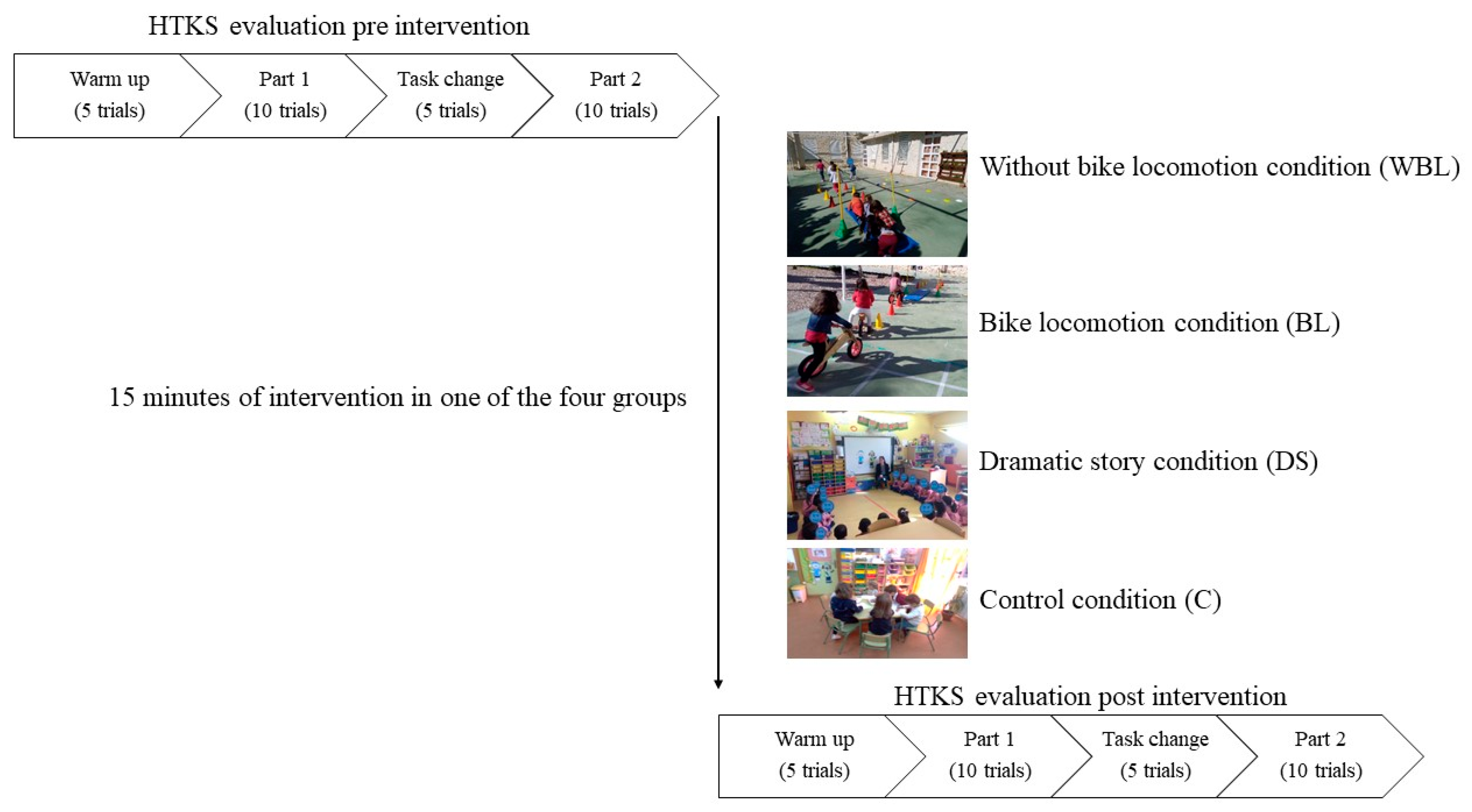

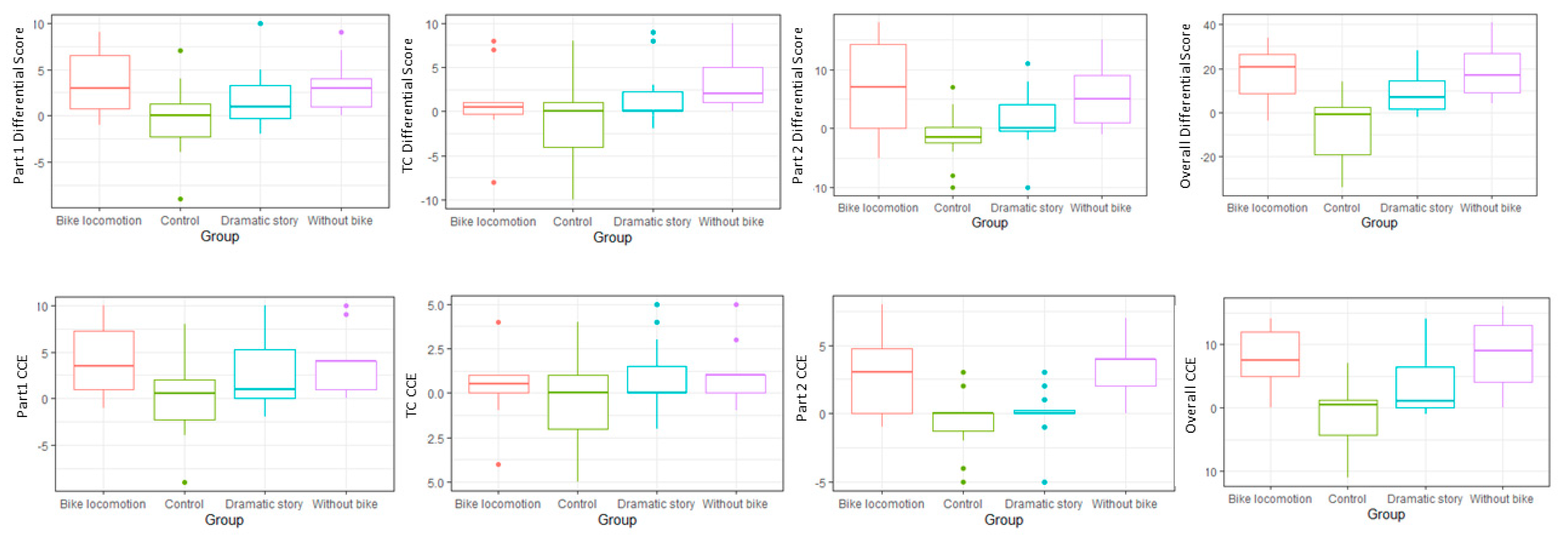
| Experimental Conditions | Description | Executive Function Involvement |
| -Without Bike Locomotion Condition (WBL) An obstacle circuit was elaborated. The children had to go through the enchanted forest to save our friends Migo and Miga. 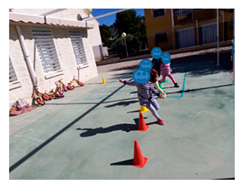 -Bike Locomotion Condition (BL) It is the same as the WBL group, although the children had to perform the circuit with a bike without pedals. 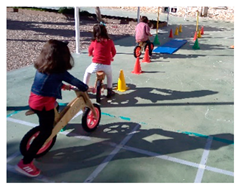 | The circuit was divided into the following sections: Forest: in a delimited area, coloured cones were placed in a row, to zigzag without touching them. Tunnel: next, a tunnel with spikes for displacement, and a ramp with inclination was placed. Bridge: there was a coloured ribbon on the ground with different shapes, and they have to pass over in balance. Ponds: next to it, several disordered blocks will be placed, in order to pass between them without touching them. When they reached the final cone, they turned around and made the same circuit backwards. The circuit was performed three times. The difficulty was increased by adding more prevailing behaviour inhibition demands. In the second round, the teacher could change the information regarding each station. For example, when they got to the forest, the teacher said to go to the tunnel section. In the third round, a new rule called witch rule was included. If the teacher said this word, all the children should stop and go back to the beginning of the circuit. | Remember the rule associated with the material; adapt to rule changes, remember different rules and motor actions; facing with interfering distractors (such as other children’s movements); inhibit predominant motor responses; give a flexible motor response to the motor challenges of the circuit through adaptive locomotion:
|
| Dramatic Story Condition (DS) | Description | Executive Function Involvement |
-Reading and dramatization of the story “Mystery in the cycling witch’s castle”.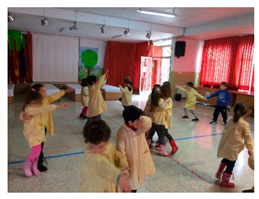 | Execute the dramatization by doing as if they were the characters according to the story of the narrated story (example): However, Migo and Miga had to be very careful, because it was not easy to get to that place, and we have to move very slowly so that the little monsters cannot see us (we move slowly through space). To get to the fantastic world, you first have to cross the field of the little monster Bicifoot (we pretend we go through the field on tiptoe so as not to make noise). | Deal with interfering distractors (movements of other children); Give a flexible motor response to the motor challenges of tasks through adaptive locomotion: dynamic and static balances; self-control of impulsivity towards task demands (standing still and performing specific motor action). |
| Control condition (C) | Description | Executive function involvement |
Paint MIGO and MIGA characters | Paint sheet of the two characters Migo and Miga. 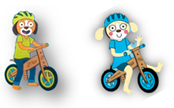 | To inhibit predominant responses (Paint according to the colours established in the model sheet). |
| Variable | Bike | Bikeless | Acting | Painting | ||||
|---|---|---|---|---|---|---|---|---|
| Mean | SD | Mean | SD | Mean | SD | Mean | SD | |
| Age (months) | 53.92 | 2.99 | 54.54 | 3.92 | 55.51 | 3.47 | 53.58 | 3.63 |
| GDC | 39.01 | 17.83 | 39.33 | 24.18 | - | - | - | - |
| Warm-up PRE | 7.08 | 4.51 | 8.54 | 4.41 | 8.25 | 5.21 | 11.58 | 0.51 |
| Part 1 PRE | 7.17 | 8.08 | 10.08 | 7.59 | 7.58 | 7.61 | 12.67 | 6.91 |
| TC PRE | 6.92 | 3.84 | 6.31 | 3.98 | 5.58 | 4.52 | 6.75 | 4.11 |
| Part 2 PRE | 4.42 | 5.11 | 8.92 | 6.61 | 5.92 | 6.24 | 5.08 | 5.48 |
| Overall PRE | 25.17 | 14.186 | 32.62 | 16.09 | 27.17 | 20.68 | 36.00 | 12.00 |
| Warm up POST | 10.42 | 2.712 | 10.54 | 2.22 | 9.33 | 4.92 | 8.75 | 5.08 |
| Part 1 POST | 13.75 | 7.83 | 16.54 | 5.33 | 12.00 | 8.12 | 11.67 | 8.37 |
| TC POST | 7.67 | 3.65 | 9.62 | 1.61 | 7.33 | 4.45 | 5.08 | 4.72 |
| Part 2 POST | 11.00 | 7.348 | 14.69 | 4.97 | 7.08 | 6.85 | 3.67 | 6.31 |
| Overall POST | 42.83 | 18.46 | 51.38 | 12.48 | 35.75 | 22.21 | 29.17 | 17.69 |
| Warm up DIF | 3.33 | 4.29 | 2.00 | 4.637 | 1.08 | 1.83 | −2.83 | 5.11 |
| Part 1 DIF | 6.58 | 8.27 | 6.46 | 6.61 | 4.42 | 6.47 | −1.00 | 8.71 |
| TC DIF | 0.75 | 4.01 | 3.31 | 3.49 | 1.75 | 3.38 | −1.67 | 5.58 |
| Part 2 DIF | 6.58 | 8.18 | 5.77 | 5.41 | 1.17 | 5.31 | −1.42 | 4.62 |
| Overall DIF | 17.67 | 11.91 | 18.77 | 11.88 | 8.58 | 9.25 | −6.83 | 14.71 |
| Part 1 CCE | 4.08 | 3.81 | 4.08 | 3.52 | 2.42 | 3.63 | 0.00 | 4.26 |
| TC CCE | 0.58 | 2.11 | 1.31 | 1.88 | 1.00 | 2.00 | −0.75 | 2.83 |
| Part 2 CCE | 3.00 | 3.21 | 3.31 | 1.93 | 0.00 | 1.91 | −0.67 | 2.23 |
| Overall CCE | 7.67 | 4.49 | 8.69 | 5.25 | 3.42 | 4.88 | −1.42 | 5.36 |
Publisher’s Note: MDPI stays neutral with regard to jurisdictional claims in published maps and institutional affiliations. |
© 2020 by the authors. Licensee MDPI, Basel, Switzerland. This article is an open access article distributed under the terms and conditions of the Creative Commons Attribution (CC BY) license (http://creativecommons.org/licenses/by/4.0/).
Share and Cite
Ureña, N.; Fernández, N.; Cárdenas, D.; Madinabeitia, I.; Alarcón, F. Acute Effect of Cognitive Compromise during Physical Exercise on Self-Regulation in Early Childhood Education. Int. J. Environ. Res. Public Health 2020, 17, 9325. https://doi.org/10.3390/ijerph17249325
Ureña N, Fernández N, Cárdenas D, Madinabeitia I, Alarcón F. Acute Effect of Cognitive Compromise during Physical Exercise on Self-Regulation in Early Childhood Education. International Journal of Environmental Research and Public Health. 2020; 17(24):9325. https://doi.org/10.3390/ijerph17249325
Chicago/Turabian StyleUreña, Nuria, Noelia Fernández, David Cárdenas, Iker Madinabeitia, and Francisco Alarcón. 2020. "Acute Effect of Cognitive Compromise during Physical Exercise on Self-Regulation in Early Childhood Education" International Journal of Environmental Research and Public Health 17, no. 24: 9325. https://doi.org/10.3390/ijerph17249325
APA StyleUreña, N., Fernández, N., Cárdenas, D., Madinabeitia, I., & Alarcón, F. (2020). Acute Effect of Cognitive Compromise during Physical Exercise on Self-Regulation in Early Childhood Education. International Journal of Environmental Research and Public Health, 17(24), 9325. https://doi.org/10.3390/ijerph17249325





